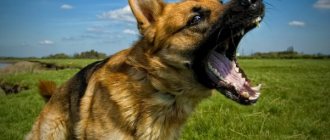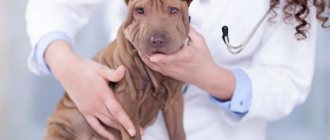A pack of stray dogs
One of the common reasons people go to the emergency room is a bite from street dogs. It’s good if the victim immediately consults a doctor, and some people don’t even have an idea of what to do if they’ve been bitten by a dog, so they’re in no hurry to treat the wound, thereby exposing themselves to mortal danger.
A stray dog can be infected with the rabies virus, which, when it enters the human body, quickly paralyzes the respiratory center and nervous system, causing painful death.
- Is a dog on the street a cute animal or a deadly threat?
- Types of bites and their danger to humans. Emergency first aid for a bite from a yard dog.
- If the bite is accompanied by bleeding
Is a dog on the street a cute animal or a deadly threat?
Dog attack on a person (photo)
Surely, many people know the situation when you are walking down the street, not bothering anyone, and suddenly a street dog appears from somewhere and grabs your legs with its teeth.
The main reasons for attacks by stray dogs on people are:
- fear of animals - often dogs killed by people prefer to attack first, since they see everyone as a threat;
- protection of puppies - if a four-legged mother is feeding her offspring nearby, then they will never let people get close, even if you are just passing by;
- dogs fighting with each other - it often happens that passers-by accidentally get into a “dog showdown”, especially if they are trying to break up the fighters - in this situation, dogs can be extremely aggressive and dangerous;
- disease with the rabies virus - an infected or sick animal behaves inappropriately and can attack passers-by for no reason.
Rules for walking animals
At the federal level, a law on keeping animals and owners’ responsibility has not been adopted, although it has long been under discussion. Only regional regulations and individual norms prescribed in different documents apply.
Thus, according to Moscow legislation, it is allowed to take pets outside if a number of requirements are met:
- on a leash indicating the animal’s name, the owner’s address, and his phone number;
- Letting off a leash is allowed in uncrowded places;
- Put muzzles on “vicious” animals.
There are no instructions in the document about which dogs are considered vicious, although we are talking about the uncontrolled actions of animals that pose a source of increased danger.
How to walk your dog?
There is no specific law that regulates the rules of walking. However, there are several legislative acts that are described in various documents that state the following.
How to walk your dog:
- To walk your dog, you need to put a collar on it with the owner's name, address and phone number. It is allowed to let the dog loose, that is, let it off the leash, only in places where there are practically no people walking.
- If the animal is aggressive, it is walked with muzzles.
- The most interesting thing is that these documents do not provide a clear justification for which dog should be considered vicious or aggressive. Accordingly, the owner himself may not consider his pet dangerous, and therefore do not put a muzzle on him and let him off the leash.
- Very often the victim itself becomes the culprit of the bite. This happens due to improper behavior in the presence of an animal.
Dog attack
Types of bites and their danger to humans
Dog bite marks
Depending on how deeply the tissues are affected during an animal attack, bites are differentiated by severity.
| Type of damage | What is it characterized by? |
| Superficial bite | It is diagnosed when the upper layers of the skin are slightly damaged by dog teeth. Often these are scratches that do not reach deep layers and heal quickly with proper treatment of the wound |
| Deep bite | The dog bites through all layers of the skin with its teeth and injures muscles or tendons. Such a bite requires repeated treatment, treatment with antibacterial drugs, administration of vaccines to the victim against rabies and tetanus, and in some situations, stitches are required |
| Ragged Bite | The dog chews out a piece of tissue, which leads to the development of serious bleeding, sometimes life-threatening, depending on which vessel is torn (vein, artery). Lacerated bites are treated surgically with mandatory suturing of the wound edges, drainage, repeated treatment and mandatory antibiotic therapy. Such bites most often do not heal well and cause complications. |
Important! Regardless of the severity of the injury and the depth of the bite, the victim must urgently go to the emergency room. Bites from stray dogs are especially dangerous to humans, as the animal can carry the rabies virus and other life-threatening infections. A person’s health and life depend on how timely and correctly emergency care is provided.
Emergency first aid for a dog bite
How to properly treat a bite site?
Statistics show that stray dogs most often attack children because they see them as a threat or a weak opponent (a child cannot fight back an attacking animal like an adult). The dog's favorite places to bite are children's legs, stomach, back, face, head.
If a child is bitten by a stray dog, it is important to react immediately, since even a minute of delay is the cost of life and a high risk of complications.
Below are detailed instructions for step-by-step actions in the event of a stray dog attack:
- A small amount of blood should be immediately squeezed out from the bite site by squeezing the skin on both sides - this will help reduce the concentration of pathogenic bacteria and the life-threatening rabies virus in the wound if the dog is infected with it.
- Laundry soap is your best friend! Dog bites should be thoroughly washed with a bar of brown laundry soap and rinsed under running water. Repeat the procedure twice. The thing is that an unattractive and unfragrant piece of laundry soap contains a huge amount of alkali, which dissolves the protective capsule of the pathogenic bacteria and creates conditions in the wound that are unfavorable for the growth and reproduction of pathogenic flora. In addition, laundry soap does not contain artificial flavors, additives or fragrances, which significantly reduces the risk of developing an allergic reaction. Of course, if you don’t have such a universal bar at hand, then an ordinary piece of children’s toilet soap will do.
- Antiseptics - brilliant green, Furacilin, an aqueous solution of iodine, Miramistin or hydrogen peroxide - anything that can destroy bacteria and viruses in the wound before arriving at the trampnukt will do. It is best to pour the antiseptic directly onto the wound, without using cotton wool or bandages, so that threads or villi do not get into it, as this can cause a secondary infection and rotting of the bite site.
- The wound surface should be covered with a sterile gauze pad or just a clean, ironed cotton cloth. The victim is immediately taken to the hospital's trauma department.
If the bite is accompanied by bleeding
Methods for treating bleeding bites: consultation with a doctor
In case of lacerated dog bites, which are accompanied by massive bleeding, before starting any action, the victim must be given an anesthetic and stop the loss of blood - to do this, use a tourniquet or simply clamp the site of the pulsation of the vessel with your fingers until the ambulance arrives. How to properly provide assistance to a victim of a stray dog bite with bleeding is described in more detail in the video in this article.
Child and dog
What is rabies?
Rabies (or rabies, from the Latin word rabies, hydrophobia, fear of water) is an acute infectious disease resulting from the bite of a dog or other infected animal, which is characterized by severe damage to the nervous system and usually ends in death.
The danger of rabies was known in ancient times, but there were no treatment methods, and every victim was doomed to death.
Only the great French scientist Louis Pasteur managed to create a vaccine against rabies (rabies vaccine) in 1885. On July 6, 1885, he saved the life of a 15-year-old teenager who was bitten by a rabid dog.
How does rabies become infected?
The causative agent of rabies is the Neuroiyctes rabid virus, which contains a single strand of RNA. The virus is resistant to freezing, antibiotics and phenol, drying, and direct sunlight. Destroyed by heat, acids and alkalis.
When a dog (or other animal) bites, infection occurs as a result of saliva from a rabid animal entering the wound. Once under the skin, the rabies virus quickly reaches the central and peripheral nervous systems. The rate of spread of the disease depends on the location of the wound (the higher the bite site, the faster the infection), the depth and size of the wound, and the reactogenicity of the human body (i.e., the susceptibility of the nervous system to a given pathogen).
1 Dog bite. First aid
2 Dog bite. First aid
3 Dog bite. First aid
Symptoms of rabies
The incubation period lasts from 1 to 3 months (sometimes from 12 days to a year). The speed of spread is influenced by the location of the bite.
There are 3 stages of the disease: initial (depression), stage of excitement, stage of paralysis.
Stage 1 of rabies:
- unpleasant sensations at the site of the bite with irradiation to the center, itching, hyperesthesia of the skin, although the wound may already have healed;
- sometimes inflammation reappears at the wound site, the scar becomes red and swollen;
- if the bite is on the face, then olfactory and visual hallucinations are observed;
- general weakness, headaches;
- nervousness and irritability;
- disruption of the gastrointestinal tract (decreased appetite, nausea, vomiting);
- constant increase in temperature to 37-37.5 degrees;
- disruption of the nervous system (sadness, fear, anxiety, apathy, nightmares);
- severe sensitivity of vision and hearing (ordinary sound or light begins to interfere).
Stage 2 of rabies - agitation (lasts from 2 to 4 days):
- the appearance of anxiety, increased heart rate;
- difficulty breathing and swallowing;
- the appearance and intensification of hydrophobia (fear is caused by the splashing, murmur, transfusion of water, its appearance, etc.);
- fear of light, loud sounds, open air (accompanied by muscle spasms and twitching, breathing problems);
- convulsions;
- attacks of aggression (a person scratches, bites, spits, fights, hits walls);
- disturbance of reason (appearance of delusional ideas, visual and auditory hallucinations).
After the attack passes, the person calms down and feels good.
Stage 3 rabies:
Symptoms of rabies at the stage of paralysis are associated with loss of activity of the subcortical formations and cerebral cortex, manifested in a weakening of sensory and motor functions.
The attacks stop. Body temperature rises to 40-42 degrees, hypotension and tachycardia appear. Death can occur within a day due to paralysis or cardiac arrest.
Treatment for dog bites
If you are bitten by a stray street dog, you should definitely inform your doctor about it. The ideal option would be to catch the dog and examine it for the presence of the rabies virus and other dangerous diseases. If this is not possible, then the victim, after treating and suturing the wound, is left in the hospital under observation for 3 weeks.
During this period, the wound surface is sanitized daily with antiseptic solutions and the bandage is changed. In addition, the victim must be prescribed a course of treatment with broad-spectrum antibiotics in the form of tablets or injections and anti-tetanus serum is administered to prevent the development of tetanus after a bite.
Symptoms of rabies in humans
Rabies in humans after a dog bite can be divided into 3 stages:
- At the initial stage, during the first three days, the bite site becomes inflamed with pronounced discomfort. The body feels weak, fever, intestinal upset, sleep disturbance. Hallucinations and mood swings are possible.
- is replaced . Within 2-3 days, a person’s dislike for water in all its manifestations worsens. The body is constrained by cramps and spasms.
- At the stage of blocking motor functions, the patient loses activity and sensitivity. The temperature rises, breathing and heart function are disrupted. The person dies within 24 hours.
Symptoms
Prevention of dog bites
Don't take food from street dogs
Of course, the behavior of an animal living far from people is difficult to predict, so it is better to do everything possible so that the dog has no reason to attack:
- do not approach dogs that are fighting and barking at each other;
- do not take puppies away from the mother yard dog, do not try to pet them;
- do not interfere with the animal when it is eating - the desire to pet the dog while feeding is perceived by the dog as an attempt to take food away.
The uncontrolled reproduction of street dogs is a problem for the entire population - the dogs are hungry, angry, feral, and therefore often attack people for no reason.
There are special shelters and organizations that catch stray dogs, sterilize them so that they do not reproduce, and vaccinate them against rabies; however, passers-by must also be vigilant and avoid packs of dogs to avoid becoming a victim of an attack.
What documents do you need to have after a dog bites a person?
To prove that a dog actually bit a person, you must:
- Photocopy the statement made to the police.
- Get a certificate from the emergency room.
- Make a copy of the patient's card with a record of the bite and prescribed treatment.
- Keep all receipts issued when purchasing medications to treat your injury.
Note! It would also be a good idea to print out a photo of the bite, the scene of the incident, the torn clothes and the dog involved in the incident.
Questions
Hello, I'm asking for help and advice. 2 days ago I was bitten by a dog on the street, I immediately treated the wound upon arriving home, as indicated in the instructions, but I did not squeeze out the blood before treatment. I decided not to go to the hospital, since the bite didn’t seem to be deep. Now I’ve studied the information and am very worried - can I get rabies and what should I do to prevent this disease? Maybe take some antibiotics?
Good afternoon In your situation, you should go to the emergency room as soon as possible. The doctor will assess whether the bite site has been treated correctly, examine the depth and severity of the wound, and prescribe treatment.
To determine the presence of the rabies virus in your blood, you will be prescribed special blood tests, and if the infection is confirmed, you will be under observation in the clinic and receive a course of treatment, including a series of rabies vaccinations, blood washing with partial or complete blood replacement.
As for antibiotics, they do not help prevent the development of rabies if the dog was really sick, but are prescribed to prevent secondary infection of the wound and the development of septic processes in the body, because in addition to viruses, dog saliva contains a huge amount of pathogenic bacteria.
Your doctor will tell you which drug to take, the duration of therapy and dosage. Do not delay your visit to the hospital and be healthy!
What should you do if you are bitten by your own dog, a family dog, a neighbor’s dog, a vaccinated dog, or if a puppy bites you until it bleeds?
Any dog bite requires medical examination. Before the victim reaches the emergency room, it is very important to respond correctly to the first symptoms.
What to do if bitten by a domestic dog:
- You cannot stop the first bleeding. With the help of bloody discharge, the wound will naturally partially get rid of harmful microorganisms.
- As soon as possible, arrange to take a pain reliever that will reduce severe discomfort. Before taking the drug, the limb is kept elevated.
- If it is possible to move independently, it is necessary to organize washing of the wound with a small amount of water and laundry soap. It is allowed to apply disinfectants or baby powder.
- The edges of the wound are lubricated with iodine or brilliant green. The main site of the bite is covered with a gauze bandage, which is secured with a bandage with free access to oxygen.
- After treating the wound yourself, you should definitely visit a doctor.
- If the condition worsens after a dog bite, an ambulance is called.
- If the dog has an owner, then you definitely need to find out about the animal’s vaccination schedule. If you find it difficult to navigate the conversation, first get a contact number.
Check with the owner about vaccinations
To simplify your course of treatment, encourage the owner to have the dog tested for rabies. If the owner of the animal does not cooperate with you, let him know that the details of the incident will be passed on to the appropriate services.
Compensation for damage under the law
According to the law, the victim has the right to compensate for the damage. To do this, you should complain to the court - file a statement of claim with the corresponding requirement.
Responsibility of the animal owner
In accordance with Article 1064 of the Civil Code of the Russian Federation, harm caused to a person or property is subject to compensation in full. Moral damage can also be recovered by referring to Article 151 of the Civil Code of the Russian Federation. If the animal caused serious injuries, the culprit can be punished under Article 118 of the Criminal Code of the Russian Federation.
Peaceful resolution of the issue with the dog owner
In practice, dog owners usually try to reach an agreement with the victim and voluntarily pay compensation. To resolve the issue peacefully, it is required:
- submit a claim indicating the extent of damage;
- conduct negotiations, as a result of which the perpetrator must agree to the amount of compensation;
- determine the procedure for compensation;
- draw up a receipt for receipt of funds.
If you wish, you can demand compensation for damage through the court or enter into a settlement agreement with the dog owner
Filing a claim in court
The statement of claim must contain the following information:
- Name of the court.
- Full name and other personal information of the applicant.
- Information about the guilty party.
- Circumstances of the case, amount of damage, references to legislative acts.
- Signature, date, list of attachments.
How is the amount of compensation for damage determined?
The amount to be compensated must be proportionate to the damage caused. The amount of payment is determined by the cost of treatment, the cost of items damaged as a result of the attack, and the degree of moral suffering of the victim. Usually the amount of compensation does not exceed 50 thousand rubles.
If the victim of the attack is a child
Children cannot be fully responsible for their actions and realize the danger that comes from the dog. Therefore, they often become victims of attacks.
If a dog bites a child, then the blame for this lies not only with the owner of the animal, but also with the parents of the child. They need to be taught from an early age that they should not provoke a dog into aggression.
Parents need to act in the same way as in a situation with an attack on an adult - go to the hospital, write a statement and seek compensation from the owner of the animal.
What to discuss with the dog owner
The owner of a dog that has bitten a person should take the phone number and ask whether the animal has been vaccinated against rabies.
After a bite, the dog owner must go to a veterinary clinic, where the animal will be examined and placed in quarantine for 10 days. Based on the decision of the veterinarian, the animal can undergo quarantine at home.
If the dog owner does not make contact with the injured party, it is necessary to contact the police, as this is a violation of the rules for keeping animals. Witnesses can help identify the owner.
If the bitten dog is a stray, the district administration is notified of the situation, which is obliged to begin catching it.
If the owner was not near the dog at the time of the bite, the victim should contact the administration. After catching a dog, its owner is identified by the tag attached to it.











